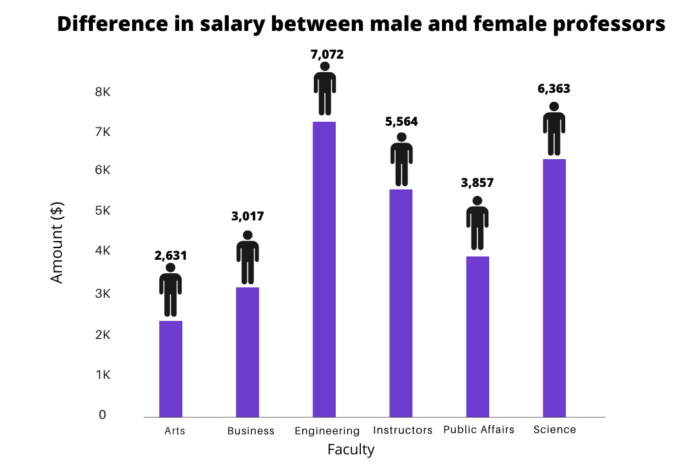The most recent salary and benefit information on Carleton University professors shows a gendered wage gap still exists among the university’s faculty members.
A 2018 study by a Carleton University biology professor and former Board of Governors (BoG) member, Root Gorelick, found on average that female contract professors in the faculties of arts, engineering, science and public affairs made $4,809.75 less than their male counterparts.
“So far, my experience has been great,” Leila Monstaço-Guidolin, an assistant professor of computer systems and engineering at Carleton University since January, said over email.
“My department and colleagues have been very warm and welcoming, also making an effort to put me in contact with other female colleagues,” she added.
Monstaço-Guidolin said she has never faced any gender-based discrimination while pursuing her engineering career, which she thinks shows a positive societal shift over the past 10 to 15 years.
However, she said she realizes she “might have been lucky so far.”
“My [female] supervisor has shared stories where being a female played a negative role in academia.” — Leila Monstaço-Guidolin, assistant professor.
Monstaço-Guidolin added there is not a lot of female representation in her fields of engineering or physics.
“There are not many females,” she said. “However, it has been slowly changing over the years.”
Emily Hiltz, a communications professor at Carleton University, said the female representation in her faculty is completely different.
“Whether it be the size of the faculty, I don’t know, but there are many females in the faculty [of communication and media studies],” Hiltz said.
Female representation at Carleton University greatly differs depending on faculty. Eighty per cent of the women’s and gender studies faculty are female, whereas under 20 per cent of the mechanical and aerospace engineering faculty is female.
“Often there are female professors, but it depends on the faculty and who you end up with inevitably,” second-year psychology student Elyse Armstrong said.
“But in terms of TA’s [teaching assistants], just based on what I have seen, the split is pretty even,” she said. “You’ve got a fair chance at either.”
Monstaço-Guidolin said she thinks the slow, but steady, increase in female representation is due to greater attention to gender imbalances in government, universities, and general society.
“We might notice a significant change in the next few years, if all measures are being taken into place carefully.” — Leila Monstaço-Guidolin, assistant professor
“At least, that’s what most of us expect to see—both females and males,” she added.
While waiting on gender equality, both professors offered advice to young female professionals wanting to go into their respective fields of work.
“Try to get as much experience as you can, not just within school, but outside as well,” Hiltz said. “Today it all comes down to experience.”
Monstaço-Guidolin said she tries to be a good role model for the next generation of females entering in the field of engineering, physics, and research. But nothing should stop people from going after their passions, she added.
“Don’t be afraid to pursue your career,” Monstaço-Guidolin said. “Everyone is capable of achieving great things and I am not just talking about women.”
“Anybody, being part of a visible minority or not, should strive to follow your interests,” she added.
“The road might not always be smooth, but you will more often than not find people willing to help you and if it is your true passion, you will always find ways to succeed.”
Featured infographic by Safiyah Marhnouj.






